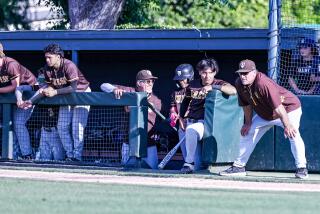Mission Ready to Get the Ball Rolling Again
- Share via
From the president’s office at Mission College, Adriana Barrera can almost hear the ping of baseball and softball bats, and the footsteps of cross-country runners.
After months of uncertainty about when, or if, the school might reinstate its athletic program on a limited basis, Barrera is increasingly more confident that there will be sports at the Sylmar school.
“I anticipate I’ll be able to name an athletic director in the fall,” Barrera said.
Once that position is filled, Barrera expects Mission to move forward with the hiring of coaches and the recruitment of student-athletes to field baseball, softball and men’s and women’s cross-country teams for the 2002-03 school year.
The timeline doesn’t conform to the 2001-02 target date announced by school officials early last year, and is not as expeditious as some community activists wanted, but Barrera said it is the prudent approach.
“I wanted to make sure we followed proper procedures,” Barrera said.
Barrera, who became Mission’s president last July, had to reconcile the prospect of adding a sports program while there are more pressing and higher-priority needs at the college.
She said several key concerns, such as the hiring of additional faculty and staff to handle a rapidly growing student population and resurrecting its performing arts program, were on the Mission agenda alongside sports.
Barrera also wanted to ensure the faculty that academic needs would not be compromised for the sake of athletics.
“At this point and time, I’ve pretty much talked with various faculty leaders and I’ve gotten their support,” Barrera said. “From their standpoint, fulfilling some of the commitments, like increasing full-time teacher hiring, has eased their concerns.”
Barrera said Mission has a full-time staff of 82, including counselors and other personnel, to serve a student body that reached 7,100 last semester. The school hired five teachers in the spring and plans to hire eight teachers in the fall and five more next spring.
The attention paid by Barrera to academic issues are welcome by faculty members such as Mike Reynolds, an outspoken science professor and former swimmer at Stanford.
“I have nothing politically or philosophically against sports,” Reynolds said. “But given the finite resources here, it’s hard for me to see funds that could go to other programs go to sports.
“We need to first take care of the bread and butter. I’m not going to go out and buy my kid a pair of $150 shoes if I can’t feed his brother. . . . I just want to see these kids learn more basic skills.”
Barrera said she intends to jump-start Mission’s sports program not just to offer students an extra-curricular activity, but to help balance the college’s demographics.
“The average age of our students is 27 years,” Barrera said. “We are working very closely with our high schools to recruit the graduating seniors. Having an arts program and a sports program will certainly help our students gain a sense of college life and attract younger students.”
But launching those programs, especially athletics, is not cheap. For existing sports programs at other junior colleges, most of them relatively cash-strapped, the trick is to maintain their equipment and uniforms, spending money on replacements only when absolutely necessary.
At Mission, they have to start from scratch. No sooner had Mission dropped sports in 1997 than thieves broke into a baseball storage facility and carted off uniforms, catching gear, equipment and pitching machines.
“The budget plan that has been put together, for the four sports I mentioned, has roughly a $150,000 figure to it,” Barrera said. “I thought that was kind of low.”
Two athletic directors in the region, Chuck Ferrero of Valley and Len Mohney of Canyons, estimate the start-up cost for a junior college baseball program at around $50,000, not including coaches’ salaries and the rental and maintenance costs of fields, which Mission would have to secure through the Los Angeles County Parks and Recreations Dept. for El Cariso Park.
A baseball budget at an existing program, like most sports, must account for replacement uniforms, refurbishing equipment, transportation, annual membership fees to an athletic conference, game officials, lodging and meals at some road games and other expenses.
Baseball would be the flagship sport at Mission, likely to draw the most interest from high school players, especially those in the northeast Valley. But Gary Donatella, longtime baseball coach at Sylmar High, remains only “cautiously optimistic” about the college restoring the sport.
“It’s a crying shame they haven’t put the program back together sooner,” Donatella said. “Many kids in this area can’t afford cars and going to play baseball at Valley or Glendale or Canyons is out of the question for them.
“I believe sometimes administrators take the road of least resistance. If an administrator thinks that reinstating athletics is going to create potential headaches for him or her, they feel that sometimes the best thing to do is lay quiet until they get enough resistance that they have to do something.”
Administrators at Mission weren’t able to fly under the radar for too long after former president William E. Norlund eliminated the school’s six sports in 1997 for financial reasons. The response from community leaders and activists was swift.
The most vocal and relentless of the critics was Duke Russell, a retired electrician from Hollywood who had spearheaded similar campaigns to save athletic programs at other colleges in the region, mainly Los Angeles City and Cal State Northridge.
Russell organized rallies, pleaded with the Los Angeles Community College board of trustees to force Mission into restoring sports and sought support from politicians. The board told Russell that trustees did not “micromanage” campuses and would not force Mission to restore athletics. No politicians came forward to aid activists.
Sometimes Mission officials didn’t help. In 1998, Norlund accepted blame for the college’s forfeiture of $4.7 million in state funds for expansion of the campus. Norlund failed to solicit opinions from the public early enough to meet a deadline for using the funds.
Other school officials made miscalculations, drawing heat from the public when their grandiose plans didn’t pan out. Tom Oliver, Mission’s interim president between Norlund and Barrera, pledged the college would bring back sports by the 2001-2002 school year.
Such unfulfilled promises are among the arguments raised by Russell, who hasn’t let up on his crusade.
He believes Mission is putting up a smoke screen and could easily afford to reinstate sports through the $4,000 the school would receive from the state for each student-athlete.
Barrera said the figure is slightly less and much of the money goes toward operating expenses.
“It depends on the number of classes they are taking and the type of classes they are taking,” Barrera said.
Barrera said $111 million has been earmarked for Mission through Proposition A, to be allocated piecemeal according to the projects undertaken by the college.
Some of the funds will be used to finance a proposed on-campus gymnasium and lockers. The money also would go toward building more classrooms.
“It would be tight, but we have some space left on the 22 acres we occupy,” Barrera said. “We are moving in the right direction. I just want to have the infrastructure in place and bring back sports the right way.”






